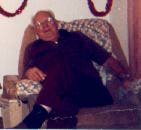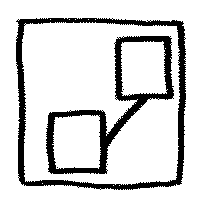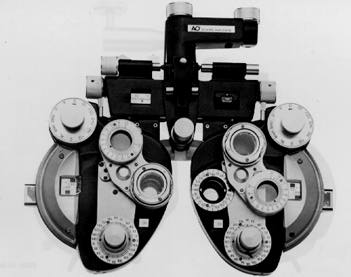
Jordan Crandall, April 1996
(on occasion of the 40th anniversary of As The World Turns)
We've even named characters after Procter & Gamble products.
Dawn was named after the
dishwashing soap and Cal's horse Comet, after the cleanser.
A face is like a work of art. It deserves a great frame.
--John Kuntz, script writer for As The World Turns, in Soap Opera
Magazine, April 2, 1996, p.
22.
--LA Eyeworks
Picture this:
Ensconced comfortably in our armchair in front of the television set,

we tune in ("access") As the World Turns, for the latest episode. Suddenly,

in the midst of the melodrama, the death of the seasoned character Chris Hughes occurs, and the show concludes as follows: A framed photograph of Hughes is placed atop the family piano, which then dissolves into a mawkish flashback montage of over thirty years of his memorable moments on the venerable series. Studio-superimposed on top of the framed photograph is an epitaph for "Don MacLaughlin" (born in 1906), which serves to memorialize the real actor who played the role. We realize, then, that what we are witnessing is no ordinary soap death, for in this episode real life intrudes upon the fictive world of the soap: a convergence of the actor's death and the character's death has been instituted, As the World Turns upon its representation. (Had the character been younger, the role might have been recast or the character sent off into the wilderness outside of the soap's normative territory, effectively excising him.)
Basically, then, we have the face of the aged actor/character MacLaughlin/Hughes, ringed with three sets of frames: the frame of the photo, the frame of the epitaph, and the frame of the television screen. Through this alignment of frames, which serve to signify both the actor outside the fiction and the character inside the fiction, we view the identity construct of MacLaughlin/Hughes, which exists neither "within" or "without" in any meaningful way, but somewhere in between. The image stands within a tensional field, in oscillation. It could be diagrammed like this


It problematizes the other end of the viewing spectrum as well, which also stands in oscillation. We have frames encircling our own heads--which constitute psychological, social, and cultural framings of viewership--as we consider this soap spectacle. It is as if, then, these frames come into play in various combinations between us and the television screen. This process is somewhat like bellying up to the ophthalmologist's Phoroptor, where various combinations of lenses are lowered or raised in front of the eyes in order to test sight, possibly fitting vision for frames.

The Ultramatic Rx Master Phoroptor has accessible operation controls, high contrast scales that are easy to read in dim light, reduced time for cross cylinder axis and power checks, and simplified near testing, power determination, and vertex measurement... The patient looks through the optical centers of the instrument lenses insuring overlapping fields and the widest possible field of view.The armchair in the living room and the armchair in the ophthalmologist's office blur into one normative seat, whose molded contours fit our ass and arms, in order to prepare the body for this examination apparatus, lowered in front of and pressed against the face, possibly resulting in the adoption of corrective lenses or soft contacts to be worn directly on the eyeballs. The patient sees through an alignment of overlapping fields or frames ("access configuration" or "zone of conduction"), which sedimentates and fixes both the object of its viewing and its embodied position as viewing subject. In other words, it becomes what it watches.
The World Turns, then, not upon any web paradigm, but upon something else-- unvisualizable because it is that mechanism that participates in the construction of vision. Perhaps it is closer to "network" in its traditional sense

(and it's no mistake that this logo evokes an eyeball) than in its newer, online sense, but in either case, it involves the embodied subject on the one hand, and new forms of institutional and discursive power on the other--with the increasingly disembodied visual faculty negotiating alignments and dispersals in between.